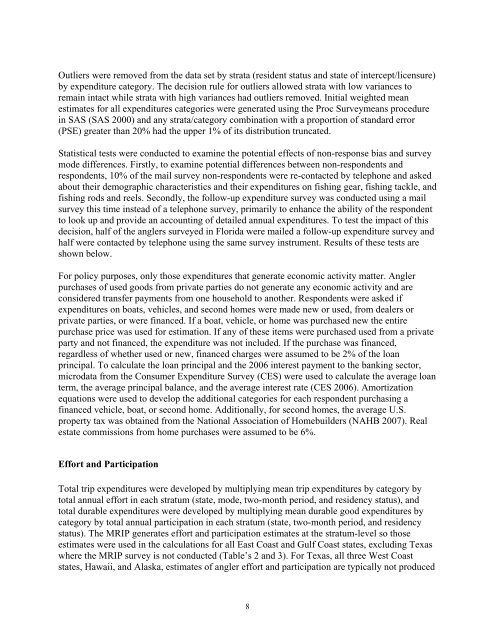The Economic Contribution of Marine Angler Expenditures in the ...
The Economic Contribution of Marine Angler Expenditures in the ...
The Economic Contribution of Marine Angler Expenditures in the ...
Create successful ePaper yourself
Turn your PDF publications into a flip-book with our unique Google optimized e-Paper software.
Outliers were removed from <strong>the</strong> data set by strata (resident status and state <strong>of</strong> <strong>in</strong>tercept/licensure)<br />
by expenditure category. <strong>The</strong> decision rule for outliers allowed strata with low variances to<br />
rema<strong>in</strong> <strong>in</strong>tact while strata with high variances had outliers removed. Initial weighted mean<br />
estimates for all expenditures categories were generated us<strong>in</strong>g <strong>the</strong> Proc Surveymeans procedure<br />
<strong>in</strong> SAS (SAS 2000) and any strata/category comb<strong>in</strong>ation with a proportion <strong>of</strong> standard error<br />
(PSE) greater than 20% had <strong>the</strong> upper 1% <strong>of</strong> its distribution truncated.<br />
Statistical tests were conducted to exam<strong>in</strong>e <strong>the</strong> potential effects <strong>of</strong> non-response bias and survey<br />
mode differences. Firstly, to exam<strong>in</strong>e potential differences between non-respondents and<br />
respondents, 10% <strong>of</strong> <strong>the</strong> mail survey non-respondents were re-contacted by telephone and asked<br />
about <strong>the</strong>ir demographic characteristics and <strong>the</strong>ir expenditures on fish<strong>in</strong>g gear, fish<strong>in</strong>g tackle, and<br />
fish<strong>in</strong>g rods and reels. Secondly, <strong>the</strong> follow-up expenditure survey was conducted us<strong>in</strong>g a mail<br />
survey this time <strong>in</strong>stead <strong>of</strong> a telephone survey, primarily to enhance <strong>the</strong> ability <strong>of</strong> <strong>the</strong> respondent<br />
to look up and provide an account<strong>in</strong>g <strong>of</strong> detailed annual expenditures. To test <strong>the</strong> impact <strong>of</strong> this<br />
decision, half <strong>of</strong> <strong>the</strong> anglers surveyed <strong>in</strong> Florida were mailed a follow-up expenditure survey and<br />
half were contacted by telephone us<strong>in</strong>g <strong>the</strong> same survey <strong>in</strong>strument. Results <strong>of</strong> <strong>the</strong>se tests are<br />
shown below.<br />
For policy purposes, only those expenditures that generate economic activity matter. <strong>Angler</strong><br />
purchases <strong>of</strong> used goods from private parties do not generate any economic activity and are<br />
considered transfer payments from one household to ano<strong>the</strong>r. Respondents were asked if<br />
expenditures on boats, vehicles, and second homes were made new or used, from dealers or<br />
private parties, or were f<strong>in</strong>anced. If a boat, vehicle, or home was purchased new <strong>the</strong> entire<br />
purchase price was used for estimation. If any <strong>of</strong> <strong>the</strong>se items were purchased used from a private<br />
party and not f<strong>in</strong>anced, <strong>the</strong> expenditure was not <strong>in</strong>cluded. If <strong>the</strong> purchase was f<strong>in</strong>anced,<br />
regardless <strong>of</strong> whe<strong>the</strong>r used or new, f<strong>in</strong>anced charges were assumed to be 2% <strong>of</strong> <strong>the</strong> loan<br />
pr<strong>in</strong>cipal. To calculate <strong>the</strong> loan pr<strong>in</strong>cipal and <strong>the</strong> 2006 <strong>in</strong>terest payment to <strong>the</strong> bank<strong>in</strong>g sector,<br />
microdata from <strong>the</strong> Consumer Expenditure Survey (CES) were used to calculate <strong>the</strong> average loan<br />
term, <strong>the</strong> average pr<strong>in</strong>cipal balance, and <strong>the</strong> average <strong>in</strong>terest rate (CES 2006). Amortization<br />
equations were used to develop <strong>the</strong> additional categories for each respondent purchas<strong>in</strong>g a<br />
f<strong>in</strong>anced vehicle, boat, or second home. Additionally, for second homes, <strong>the</strong> average U.S.<br />
property tax was obta<strong>in</strong>ed from <strong>the</strong> National Association <strong>of</strong> Homebuilders (NAHB 2007). Real<br />
estate commissions from home purchases were assumed to be 6%.<br />
Effort and Participation<br />
Total trip expenditures were developed by multiply<strong>in</strong>g mean trip expenditures by category by<br />
total annual effort <strong>in</strong> each stratum (state, mode, two-month period, and residency status), and<br />
total durable expenditures were developed by multiply<strong>in</strong>g mean durable good expenditures by<br />
category by total annual participation <strong>in</strong> each stratum (state, two-month period, and residency<br />
status). <strong>The</strong> MRIP generates effort and participation estimates at <strong>the</strong> stratum-level so those<br />
estimates were used <strong>in</strong> <strong>the</strong> calculations for all East Coast and Gulf Coast states, exclud<strong>in</strong>g Texas<br />
where <strong>the</strong> MRIP survey is not conducted (Table’s 2 and 3). For Texas, all three West Coast<br />
states, Hawaii, and Alaska, estimates <strong>of</strong> angler effort and participation are typically not produced<br />
8
















